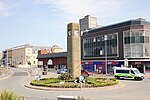Rhyl Pier

Rhyl Pier, officially known as the Victoria Pier, was a pleasure pier in the seaside town of Rhyl, Flintshire, and the first to be built in North Wales. Designed by James Brunlees and opened in August 1867 at a length of 2,355 feet (718 m), it was the town's central attraction for the ensuing years. Following dispute and public consultation regarding the location it would be built, the pier was constructed near the centre of the esplanade. The pier's Grand Pavilion, built in 1891, featured the world's largest organ, known as the Grand Jubilee Organ and weighed 25 tonnes (28 short tons). Several incidents occurred during the pier's lifespan, in particular during the late 19th century of boats crashing into the pier. In 1897, celebrity diver Tommy Burns fatally dived 100 feet (30 m) off the pier, observed by around 3,000 people and was declared dead shortly after being brought out of the sea. The following year in 1898, early filmmaker Arthur Cheetham presented his 'living pictures' to a full audience in the Grand Pavilion. Following years of dereliction, the pier was purchased by Rhyl Council by auction in 1913 and was operational from the 1930s until the mid-1960s, at which point it was declared unsafe and closed. Despite reports in October 1966 that the council were prepared to consider offers to reconstruct the pier, this did not materialise and it was subsequently demolished in March 1973.
Excerpt from the Wikipedia article Rhyl Pier (License: CC BY-SA 3.0, Authors, Images).Rhyl Pier
Geographical coordinates (GPS) Address Nearby Places Show on map
Geographical coordinates (GPS)
| Latitude | Longitude |
|---|---|
| N 53.32355 ° | E -3.49211 ° |
Address
LL18 1HB , Rhyl
Wales, United Kingdom
Open on Google Maps









